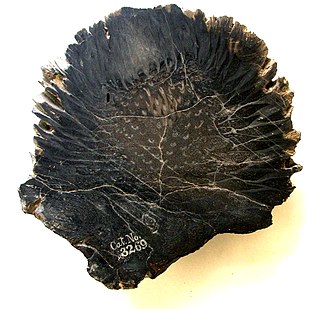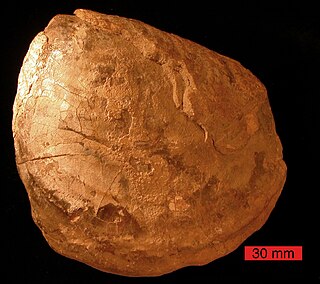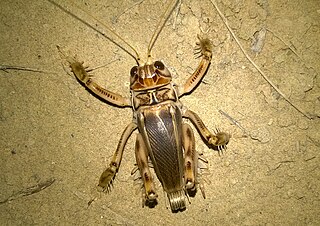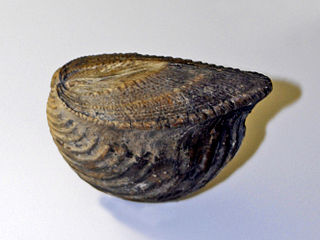 W
WAraxoceratidae is an extinct family of ceratitid ammonites, cephalopods that were found throughout the world. They arose during the Permian and died out during the early Triassic. The species of the type genus Araxoceras are used as markers for various Permian epochs.
 W
WArcheriidae is a family of embolomeres that lived in the Permian period. Archeria is a well known genus of archeriid.
 W
WBauriidae is an extinct family of therocephalian therapsids. Bauriids were the latest-surviving group of therocephalians after the Permian–Triassic extinction event, going extinct in the Middle Triassic. They are among the most advanced eutherocephalians and possess several mammal-like features such as a secondary palate and wide postcanine teeth at the back of the jaws. Unlike other therocephalians, bauriids were herbivorous. They were also smaller than earlier members of the group. Two subfamilies are classified within Bauriidae: Nothogomphodontinae and Bauriinae.
 W
WBauriinae is an extinct subfamily of therocephalian therapsids. It is one of two subdivisions of the family Bauriidae, the other being Nothogomphodontinae.
 W
WBaurioidea is a superfamily of therocephalian therapsids. It includes advanced therocephalians such as Regisaurus and Bauria. The superfamily was named by South African paleontologist Robert Broom in 1911. Bauriamorpha, named by D. M. S. Watson and Alfred Romer in 1956, is a junior synonym of Bauriodea.
 W
WBennettitales is an extinct order of seed plants that first appeared in the Permian period and became extinct in most areas toward the end of the Cretaceous, although some Bennettitales appear to have survived into Oligocene times in Tasmania and eastern Australia. Bennettitales are among the most common extinct Mesozoic seed plants, and had morphologies including shrub and cycad-like forms. The order comprises two families, the Cycadeoidaceae, represented by Cycadeoidea and Monanthesia, and the Williamsoniaceae including Williamsonia, Williamsoniella, Wielandella and Ischnophyton which had slender, branching trunks and either bisporangiate or monosporangiate strobili.
 W
WCladophlebis is an extinct form genus of fern, used to refer to Paleozoic and Mesozoic fern leaves that have "fern fronds with pinnules that are attached to the rachis, and have a median vein that runs to the apex of the pinnule, and veins from that are curved and dichotomise". By convention this genus is not used to refer to fossil ferns from the Cenozoic. Ferns with this morphology belong to several families, including Osmundaceae, Dicksoniaceae and Schizaeaceae. Ferns with this morphology are common during the Paleozoic and Mesozoic in both the northern and southern hemispheres.
 W
WCoelacanthidae is an extinct family of coelacanths found in freshwater and marine strata throughout the world, originating during the Permian, and finally dying out during the Jurassic.
 W
WCorystospermaceae is a natural family of seed ferns (Pteridospermatophyta) also called Umkomasiaceae, and first based on fossils collected by Hamshaw Thomas from the Burnera Waterfall locality near the Umkomaas River of South Africa The leaves of Dicroidium were recognized by Alex Du Toit to unite all the countries of the Gondwana supercontinent during the Triassic: Africa, South America, India, and Australia. Subsequently, Dicroidium was found in the Triassic of Antarctica and New Zealand, and also the Permian Umm Irna Formation of Jordan. According to the form generic system of paleobotany, leaves are given separate generic names to ovulate and pollen organs, but the discovery of these reproductive organs in Africa by Thomas, and subsequently throughout Gondwana, strengthened Du Toit's concept of a continuous southern supercontinent. Corystospermaceae were also components of Jurassic and Cretaceous floras, declining in the Cretaceous presumably due to the rise of flowering plants, the last representative of the group, Komlopteris cenozoicus, is known from the Eocene of Tasmania.
 W
WEosuchians are an extinct order of diapsid reptiles. Depending on which taxa are included the order may have ranged from the late Carboniferous to the Eocene but the consensus is that eosuchians are confined to the Permian and Triassic.
 W
WEutherocephalia is an infraorder of therocephalian therapsids. Eutherocephalians are distinguished from the lycosuchids and scylacosaurids, two early therocephalian families. While lycosuchids and scyalosaurids became extinct by the end of the Permian period, eutherocephalians survived the Permian–Triassic extinction event. The group eventually became extinct in the Middle Triassic.
 W
WGyroporella is an extinct genus of green algae in the family Triploporellaceae.
 W
WThe Ediacaran fossil Hallidaya, a close relative of Skinnera lived in Belomorian of the Late Ediacaran period prior to the Cambrian explosion and thrived in the marine strata on the ocean floor of what is now considered Australia. These fossils were disk-shaped organisms that were slightly dome shaped with tri-radial symmetry. These Ediacaran organisms thrived by living in low-energy inner shelf, in the wave- and current-agitated shoreface, and in the high-energy distributary systems.
 W
WThe Inoceramidae are an extinct family of bivalves ("clams") in the Class Mollusca. Fossils of inoceramids are found in marine sediments of Permian to latest Cretaceous in age. Inoceramids tended to live in upper bathyal and neritic environments.
 W
WLepidopteris callipteroides is a form species for leaves of Late Permian Pteridospermatophyta, or seed ferns, which lived from around 252 million years ago in what is now Australia, and Madagascar. Lepidopteris callipteroides was an immediate survivor of the largest Permian-Triassic extinction event, migrating southward with the post-apocalyptic greenhouse spike.
 W
WMesopsychidae is an extinct family of scorpionflies known from the Late Permian to Mid Cretaceous. It is part of Mesopsychoidea, a group of scorpionflies with siphonate proboscis. They are suggested to have been nectarivores, feeding off the liquid pollination drops and acting as pollinators for now extinct insect pollinated gymnosperms such as Bennettitales.
 W
WNeocalamites is an extinct genus of Sphenophytes. Neocalamites, thrived during the Permian and Triassic, and occurs on localities from both hemispheres.
 W
WOrodontidae is an extinct family of cartilaginous fish that lived from the late Pennsylvanian to the Early Permian in what is now North America.
 W
WPaleospinacidae is an extinct family of prehistoric sharks in the extinct order Synechodontiformes.
 W
WPeltaspermaceae is a natural family of seed ferns (Pteridospermatophyta) widespread in both northern and southern hemispheres coal measures of Permian and Triassic age.
 W
WPhragmoteuthida is an order of extinct coleoid cephalopods characterized by a fan-like teuthoid pro-ostracum attached to a belemnoid-like phragmocone.
 W
WPylaecephalidae is a family of dicynodont therapsids that includes Diictodon, Robertia, and Prosictodon from the Permian of South Africa. Pylaecephalids were small burrowing dicynodonts with long tusks. The family was first named in 1934 and was redefined in 2009. Diictodontidae and Robertiidae are considered junior synonyms of Pylaecephalidae.
 W
WRhopalodontidae is a family of dinocephalian therapsids.
 W
WRhytidostea is a clade of stereospondyl temnospondyls. It was erected in 2000 to include several temnospondyl groups distinct from the "higher" group of capitosaurs, including lydekkerinids, brachyopoids, and rhytidosteids. Rhytidosteans first appeared in the Permian period and underwent an evolutionary radiation during the Induan stage of the Early Triassic. Along with capitosaurs, rhytidosteans comprise much of the larger suborder Stereospondyli. Rhytidostea has often been considered the sister group of the clade Capitosauria, but has been placed in various other phylogenetic positions. In many studies, members of Rhytidostea are split, with lydekkerinids having a more basal position among stereospondyls while rhytidosteids and brachyopoids form a group placed among the more derived trematosaurian stereospondyls.
 W
WSchizodactylidae is a family of orthopteran insects found in Asia and Africa, known as dune crickets or splay-footed crickets. They are usually found in desert and sandy areas. Some species are predatory, including Schizodactylus inexspectatus. Detailed study has been investigated for one of the member of Schizodactylidae, S. inexspectatus, by G. Aydin. T. B. Fletcher notes that one individual did not feed on any vegetable matter.
 W
WSynechodontiformes is an extinct order of prehistoric sharks in the superorder Selachimorpha.
 W
WTrigonia is an extinct genus of saltwater clams, fossil marine bivalve mollusk in the family Trigoniidae. The fossil range of the genus spans the Paleozoic, Mesozoic and Paleocene of the Cenozoic, from 298 to 56 Ma.
 W
WUmkomasia is a genus of seed ferns (Pteridospermatophyta), and first based on fossils collected by Hamshaw Thomas from the Burnera Waterfall locality near the Umkomaas River of South Africa. He recognized on the basis of cuticular similarities that the same plant produced pollen organs Pteruchus and the leaves Dicroidium.
 W
WCorystospermaceae is a natural family of seed ferns (Pteridospermatophyta) also called Umkomasiaceae, and first based on fossils collected by Hamshaw Thomas from the Burnera Waterfall locality near the Umkomaas River of South Africa The leaves of Dicroidium were recognized by Alex Du Toit to unite all the countries of the Gondwana supercontinent during the Triassic: Africa, South America, India, and Australia. Subsequently, Dicroidium was found in the Triassic of Antarctica and New Zealand, and also the Permian Umm Irna Formation of Jordan. According to the form generic system of paleobotany, leaves are given separate generic names to ovulate and pollen organs, but the discovery of these reproductive organs in Africa by Thomas, and subsequently throughout Gondwana, strengthened Du Toit's concept of a continuous southern supercontinent. Corystospermaceae were also components of Jurassic and Cretaceous floras, declining in the Cretaceous presumably due to the rise of flowering plants, the last representative of the group, Komlopteris cenozoicus, is known from the Eocene of Tasmania.
 W
WWhaitsiidae is an extinct family of therocephalian therapsids.
 W
WYounginiformes is a replacement name for the taxon Eosuchia, proposed by Alfred Romer in 1947.